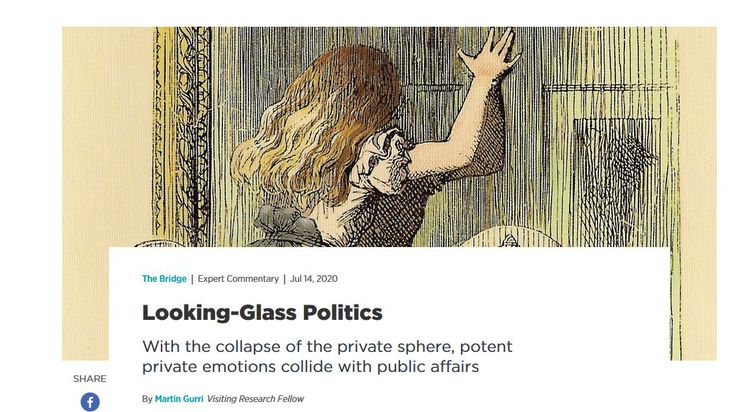
By Steve Sailer
08/09/2020
From the Mercatus Center:
Jul 14, 2020
With the collapse of the private sphere, potent private emotions collide with public affairs
Martin Gurri, Visiting Research FellowAn unconquerable anger has gripped the democratic world. The public seethes with feelings of grievance and seems ready to wreak havoc at any provocation. The spasm of fury that swept the United States after the death of George Floyd cost 19 additional lives and $400 million in property damage. …
Many books and articles have tried to explain this surge in anger. … The Harvard Gazette’s recent “Why America Can’t Escape Its Racist Roots” can stand in for an Amazonian stream of similar articles.
Anger is a huge story and thus a fat analytical target. Most of these explanations have some merit to them. However, all take it for granted that the anger is justified — the analyst’s job is simply to discover a cause commensurate with its enormity.
… Arnold Kling, to my knowledge, stands virtually alone in suggesting that the tide of political anger need not have matching political causes. He has wondered, instead, whether extreme private emotions have been diverted by the web into the public sphere. Kling brings up an interesting number: 150. Roughly speaking, that is how many persons you can remember before names, faces, and situations begin to get fuzzy. It’s often called the “Dunbar number,” after British anthropologist Robin Dunbar, who first identified this cognitive boundary in a 1992 paper, and it probably represents the hard-wiring in our minds of some maximum hunter-gatherer band size.
Has this Dunbar number theory ever been tested? It’s quite popular, but I mostly see it used in an “As everybody knows” sense.
Each of us carries along, in our everyday activities, a band of 150 people whom we can identify with fair accuracy. This humble Dunbar world provides the stage for the drama of most human lives and is the source of the most authentic human emotions. From ancestral times, the pursuit of happiness has played out almost entirely within this domain.
Kling has noted a strange development: the shock of the digital has brought the Dunbar world to the verge of collapse. Historically, he writes, the “sub-Dunbar” public concerned itself mostly with “family, friends, and co-workers.” Elites in the “super-Dunbar” world ran the “government and large organizations.” He goes on:
But new media have caused the two spheres to collide. The public feels itself on the same playing field as the elites. Anyone can comment on Twitter. So people who never used to think much about the super-Dunbar world are now trying to take part in it.
Ultimately, Kling concludes, “you feel a lot more sense of ownership of what’s going on in public life, and you care about it a lot more.” Strong personal feelings have been torn loose from the private sphere and become attached to the distant world of events.
Or, perhaps, the opposite has happened as well: Elites in the “super-Dunbar” got exposed to criticism when they went on Twitter, and thus went crazy. For example, the insanity in the mainstream media of the last 4 years about the threat supposedly posed by the Alt-Right (compared to the complete lack of attention to the much larger Antifa) may be largely due to journalists being laughed at on Twitter.
A lot of people can’t deal well with criticism. They feel like they are about to be attacked by a mob and murdered when they get a few dozen tweets making fun of them. I think that’s a better application of this Dunbar Number: If people get 76 negative responses on social media, they worry, “Oh, no, the majority of my tribe of 150 has spoken out against me! I will be made an outcast and forced to wander alone in the wilderness.”
The Floyd protests fit into this pattern. The terrible events in Powderhorn Park, Minneapolis, were local and fleeting but took place before a battery of cell phone cameras — and at once became global and searchable. The public experienced a digital murder. Because it was visual, it felt personal. Because it felt personal, the most violent emotions were aroused. Floyd seemed like a member of one’s private circle: an idealized friend. Because his death was searchable, it turned into a recurring nightmare, a wound that could not heal.
Social media rage, which feeds on itself, soon forgot the actual events and demanded cosmic and abstract judgments. This was not about George Floyd after all. This was about a monstrous injustice called “systemic racism.”
OK, but once again, is there any evidence that elites of the “Super-Dunbar” dealt more rationally with the George Floyd whoop-tee-doo? How many of them came out and said:
“Look, there are 20,000,000 black guys in America. That’s a huge number. There is always one of that 20,000,000 doing something knuckleheaded and winding up dead. You can’t let yourself go insane over some drugged-up bouncer in Minnesota. We may feel emotionally like we live in a tribe of 150, but we don’t. It’s actually a huge country, so restrain your out-of-control emotions and think sensibly. It’s just the power of The Megaphone to make you believe that George Floyd or Emmett Till is representative. Don’t fall for the statistically nonsensical Narrative.”
I sure haven’t heard many elites from the “super-Dunbar” pointing that out.
This is a content archive of VDARE.com, which Letitia James forced off of the Internet using lawfare.